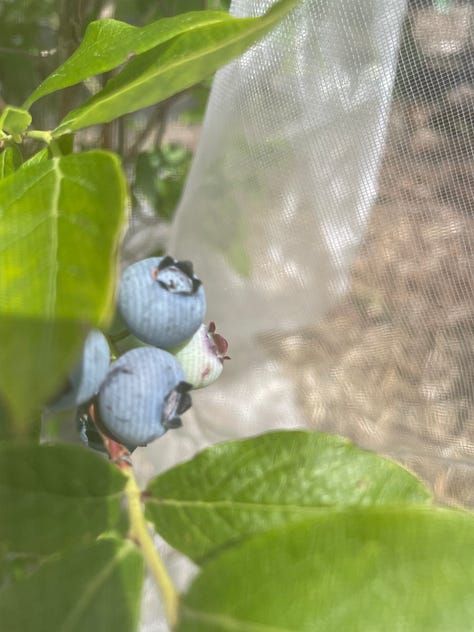What’s happening in the garden this week: June 23-29
It's tomato season, which means watering, fertilizing, tying and pruning
Lots of flowering on tomatoes
Our tomato plants growing in straw bales, beds and pots are filled with small yellow flowers, and bees and other pollinators are flitting about them, so that’s a sign we should be seeing tomatoes emerging on the vines in the not too distant future. A few tomatoes are already out. There’s a cluster on the Stupice plant, an early producing indeterminate, plus some growing on Eagle Smiley, a new-for-me dwarf plant that promises to produce some tasty yellow cherry tomatoes.
You can encourage pollination by very lightly tapping the vine near the yellow flowers. Since tomatoes are self-pollinating, the pollen shaken loose will fall within the flower to help it pollinate itself. Some people use an electric toothbrush to gently loosen the pollen. I’ll give my vines a tap every now and then but I’ve found bees and the breeze usually do the trick.
Tomato care
With the growing season now in motion, I’m doubling down on coddling the tomato plants. For me, this means:
Watering: Tomatoes love water so I’m keeping a tab on rainfall amounts each week to see whether the tomatoes I have growing in the beds need to be watered. Tomatoes in raised or in-ground beds that are rich in compost and well mulched require about an inch of water a week – from the sky or your hose. Remember to water at the bottom of the plants and avoid wetting the leaves to protect against spread of disease. Watering in the morning is best.
Watering in straw bales and pots: I water the tomatoes growing in straw bales every day by taking the hose around to them and holding the wand over the bottom of the plants for a count of 6-10 seconds. Same goes for the tomatoes I have in grow bags, which are porous. Tomatoes in pots need less since they hold the water better, though they need a little more attention than those in the ground.
Fertilizing: I fertilize tomatoes in straw bales and pots once a week with an all-purpose liquid fertilizer. I mix the fertilizer in a watering can at the correct ratio and pour a small amount – about a cup’s worth – at the bottom of each plant. I don’t use a fertilizer designed specifically for tomatoes as I think a standard fertilizer serves the same purpose. I’ve been using a fish emulsion fertilizer made by Neptune though a non-organic (and cheaper) fertilizer is just as good unless you’re committed to growing a pure organic garden. I fertilize tomatoes in my beds once a month. I found doing it more frequently is not necessary as long as the beds have been spread with an inch or so of compost over the past year.
Tying and pruning: Indeterminate tomatoes grow on vines that require staking and regular pruning and tying or they will get away from you. Standard-issue tomato cages are too small unless you want to top them when they start growing out of the cages or are prepared for them to topple over when the plants get too heavy. As a compromise, you can combine the cages with a long stake that will help anchor them and provide support once the plants get large. I have my indeterminates growing against a cattle panel fence and supported by strong 8-foot stakes. I’m tying them to the stakes or the fence about every 6-8 inches or so with soft garden twine. The vines grow fast so I sometimes do this a couple times a week. This year I’m also trying – with the emphasis on trying – to limit each plant to three main vines – the central leader and two sucker vines that I’ll allow to grow. The hope is this will give the plants enough air and light and keep them more manageable. My goal is to prune the remaining suckers – which emerge where a leafy branch meets the main stem – though this may be more aspirational than realistic.
Squash emerges
The acorn squash and zucchini seeds I planted in one of the straw bales on June 18 have emerged and are growing. I’ve grown tomatoes in straw bales but have never tried direct seeding into them until this year. With tomatoes, you dig a hole into the conditioned bale, put the plant in and cover it with a few handfuls of potting soil. To add seeds directly, you spread potting soil on top of the bale and plant the seeds into the soil. The roots then find their way into the straw.
Berry season is here
We’ve been able to harvest just enough blueberries, strawberries and raspberries each morning to add to our bowls of cereal. The plants are only now beginning to produce and there are still a lot of blueberries ripening on the vine. Same goes for the raspberries. The birds seem to be getting to the strawberries faster than we can pick them. So it’s Birds 1, Humans 2 right now.



Previous updates:
What’s happening in the garden June 16-22
What’s happening in the garden: June 9-15
What’s happening in the garden: June 2-June 8
What’s happening in the garden: May 26-June 1





What’s an Indeterminate Tomato?
Also, the self-pollinating thing sounds a little…kinky?